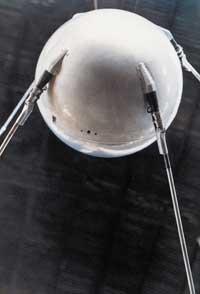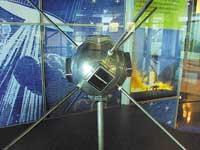Sputnik 1, the Soviet surprise

And that day the Soviets managed to put into orbit the Earth the first artificial satellite. Seen with current eyes, the satellite Sputnik 1 seems nothing great: it was a simple aluminum sphere weighing 84 kilos and whose mission was to study the density of the upper part of the atmosphere. He sent the data to Earth via a radio transmitter and, after 21 days in orbit, moved. Days later, on 4 January 1958, he entered the Earth's atmosphere and calcined completely. However, this was enough to overcome the Americans.
This war began long ago. After World War II, the two major world powers began to compete. They focused mainly on two fields: military missiles and research satellites from the upper atmosphere. They also had a deadline: 1957-1958 International Year of Geophysics, so by then it was necessary to prepare the instrument that put in orbit and send the data.
The two areas mentioned were not far from each other, but the military investigation gave them the key to winning the battle to the Soviets. To launch nuclear weapons, the Americans intended to use planes, while the Soviets had the idea of launching them with rockets. Soviet engineers designed the first ballistic missiles between continents. They soon realized that these powerful rockets had enough force to go through the atmosphere.
In June 1957, a bright spherical satellite with two antennas was ready. His official name was Iskustvennyi Sputnik Zemli, “Artificial Traveler of the Earth”. In August rockets were tested and Soviet Prime Minister Nikita Khrunshchev authorized the launch of the Sputnik satellite on 17 September. In fact, that day was one hundred years since the birth of the father of the cosmonaut Konstantin Tsiolkovsky. However, due to technical problems, they had to delay the launch.
The stimulus of the space race
Finally, the satellite was mounted on October 2 at the Baiconur cosmodrome in Kazhakhstan, where they tested the radio, covered the satellite and prepared the launcher. On October 4, coinciding with trumpet noises, when in Moscow it was 10:28 p.m., Sputnik 1 left the Earth. Surprisingly, the Soviets kept the shot secret and did not take pictures.

The minutes from the launch of the satellite to the reception of radio signals were not sweet, but the wait was worth: After 95 minutes of waiting, came the radio signal verifying that Sputnik 1 was in orbit. The official news agency TASS spread the news worldwide.
In the US, at 5:58 p.m. in New York, they received the news. President Eisenhower, with the intention of removing importance, called him “the little ball that is in the air.” But the blow was hard. In spite of trying, the Soviets advanced, we had to answer.
On July 29, 1958, Eisenhower signed the American Space Agency Creation Act and NASA was born on October 1. At the same time, a special training program for scientists and engineers was launched, which in a short time nearly tripled the budget of the Science Society.
Certainly, Sputnik 1 became the spur of space research, and until July 20, 1969, Neil Amstrong came to the Moon and said “a small step for man, a terrible step for humanity,” Soviets and Americans were matched in the space race.
Selling a sputnik

Who would say that at that time the mythical Sputnik satellites could be bought someday on the market! But it is so: now on the Internet, specifically on the Sovietski.com and eBay Inc. portals, a Sputnik has been auctioned, which has come out at the price of $25,000. If sputnika is true, experts believe it is a real shanty. For example, two years ago the Seattle Flight Museum (USA) paid $100,000 to buy a Sputnik at the Moscow Cosmonaut Museum.
However, more than one questions the authenticity of the satellite. Although several Sputnik were celebrated in the Soviet Union, no one knows how many they were. An American classic car salesman has two authentic Sputnik, and, based on his experience with cars, it seems nothing difficult to make a good fake. Yes, yours are true because they have the endorsement of the Moscow Museum of Technical Achievements.
Doubts, surely there is someone who is wanting to buy a Sputnik. If you are one of them, lucky at auction!





